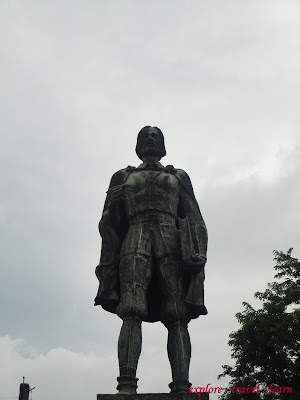Plaza Independencia, one of the significant landmark in Cebu City and it was used to be the Gobierno Provincial in downtown area of Cebu. It was in 2008 when the Plaza was reopened but the beautification & improvements of the area is still on going but that doesn't hinder the people from staying and even have picnic there.
In the center stands an obelisk that is dedicated to the first Spanish governor-general of the Philippines Miguel Lopez de Legazpi
 |
| during night time |
 |
| during daytime |
In the morning or late afternoon you can see people walking, jogging or even having a run within the Plaza ..
there's a memorial for those Filipino and Japanese who died during the war with a message that says:
"This memorial is dedicated to the Filipino - Japanese war dead during the last war. Time has taught us a lesson that no gains have been achieved by victories in war on the other hand. Peace has brought about love and brotherhood amongst the people on this earth. It is therefore our hope that there shall be no more wars in the future to come upon us and that everlasting peace shall ever reign on this earth."
Erected on one side is the statue of Antonio Pigafetta by the Philippine Italian Association in the year 1980.
"Antonio Pigafetta (1496-1535) is a Patrician of vicenza, Italy, and a knight of Malta Chronicles of the magellan Expedition that First Circumnavigated the globe from 1519-1522. He fought in Mactan and was one of the 22 survivors who returned to Spain."and on the other side is a monument called Cebu Veterans Memorial
"This monument, an eloquent oblation like hands reaching for heaven, soulful in supplication, stands for the noble living and the noble dead whose dreams and hopes shall in the end, hopefully find reward in an enduring freedom from all kinds of tyrannies, suppressions, fears and want. - Prof Julian Jumalon"
though it's not within the area of Plaza Independencia, but in one side you can have a good view of the Malacañan sa Sugbo

Some facts about Plaza Independencia:
In early 1600's it was called Plaza de Armas, a public square used as military training & parade ground. And when it was widened and expanded it was named as Plaza Mayor but when Spaniards envaded in honour to their reigning Queen they changed the name into Plaza Maria Cristina. And during the American Colonial Period they named it Plaza Libertad. Finally when the colonial masters left it was named Plaza Independencia.
The area was discovered as a rich archaelogical site when they constructed a road tunnel. They were able to uncover some prehispanic bones and earthenwares that was there since the Prehispanic settlement and trading times. Some of the artifacts that was unearthed in 2008 includes the gold death masks, a pair of gold earrings, a thai bluish-green "guan" celadon, jars and other artifacts.
MAP:










No comments:
Post a Comment